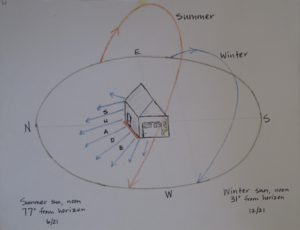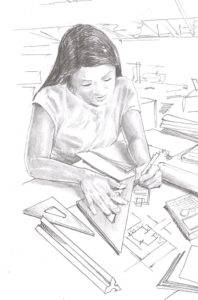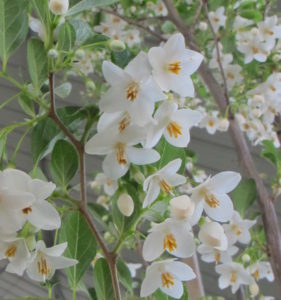It’s Time To Plant Trees!

As summer’s sizzling temperatures begin to cool off, our thoughts turn to new gardening projects. Fall is a great time to plant trees and shrubs. At that time, garden centers bring in fresh plant material, so you’ll have a wide variety to choose from.
After leaves drop from deciduous plants, roots no longer need to provide water to foliage, making fall the perfect time for landscaping. New roots, though, continue to grow well into autumn, while soil temperature remains above 40°F. By springtime, new leaves will draw water from a more extensive root system, so you won’t have to water as often as you would when planting trees in leaf.
Although you can plant trees and shrubs in full foliage, they will need frequent irrigation to get them established. The warmer the temperature, the more water the plant will require. Summer sun bearing down a dark nursery pot stresses the root system and can prevent root growth on the hottest side of the pot. It follows that during the summer months, roots would rather be in the cool earth than exposed to hot sun. Planting leafy trees just requires more attention from the gardener.
Most evergreens also can be planted in autumn. Their foliage at that time transpires less water to the atmosphere as temperatures cool down and day length shortens.
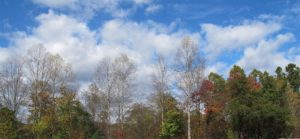
Room For Improvement
During my search for a new home, what always attracts my attention first is the presence of mature trees. The absence of trees means more grass to mow, for a while, anyway. Not my cup of tea.
Because the Covid-19 pandemic has kept us closer to home, we can’t help but notice areas that could use improvement. Is the sunroom or the shed a bit too toasty in the afternoon? Gazing at the computer screen hour after hour? Now that you’re working from home, looking upon a pretty garden outside the office or pulling a few weeds would provide a needed break. Perhaps you’ve discovered that connecting with nature relieves stress and gives you a feeling of calm and comfort.
Those are just a few reasons to plant trees and spruce up our gardens. Converting high maintenance lawns into gardens with colorful trees, shrubs, and flowers not only enhances aesthetics, but also increases the value of our homes. And with all this talk of carbon footprints and deforestation, perhaps you’re eager to participate in the solution.
Plant Trees To Transform Your Landscape, In Two Parts
Part 1 of “Plant Trees To Transform Your Landscape” addresses seasonal changes, drawing a landscape plan, reasons for planting trees and shrubs, slope, and practical considerations.
Part 2 of “Plant Trees To Transform Your Landscape” details soil preparation and the process of planting trees in the landscape. I also write about native plants vs. the non-natives, and how they affect populations of insects and animals.
The Sun’s Path
Start thinking about your landscape now, before summer’s discomfort fades from memory. Notice how the sun’s arc changes from month to month, and how, by mid- to late summer, it’s already lower in the sky. My little succulents lining the south-facing bay windows get more direct sunlight now than they did a month ago, when the sun was directly overhead.
You can block much of the heat and sunlight falling on the south (northern hemisphere) or west side of the house with a deciduous tree or a group of trees. If you want maximum sunlight coming indoors during the winter, however, avoid planting trees right outside south-facing windows. Instead, shift the trees toward the southwest or the west, which will give you more sun in winter and shade on a hot summer afternoon.
Although deciduous trees drop leaves in autumn, bare branches and twigs will cast some shade. But with carefully placed trees—not directly south—shade will come from smaller twigs on the canopy’s periphery rather than from stout trunks and limbs.
Large evergreens block winter sun at a time when it is most welcome if they’re planted near south-, southeast-, or southwest-facing windows. Consider planting them farther out into the landscape and where they can reduce winter wind from the north or the west. Or use shorter evergreens that mature below windowsill height. Thick borders of twiggy deciduous plant material can decrease wind speed, but not as effectively as evergreens.
For the Record
It helps to keep a record of these seasonal changes. Visualize how tree placement will affect sunlight falling on your house or coming through the windows. Knowing a tree’s mature height and spread will help determine where to place it for maximum solar gain in winter and shade in summer.
Avoid planting trees too close to the house, where leaves, flowers, and fruits will litter the sidewalk and clog the gutters…not just in year 1, but also in year 31. Realistically, though, debris will get into uncovered gutters and leaves will swirl around paved areas, but planting trees far enough from the house will obviate the need for annoyingly frequent maintenance. In addition, limbs growing toward the house will require trimming, and the result often falls short of appealing.
These are merely guidelines that I’m suggesting, but, ultimately, it’s your property and your choice.
Let’s not forget the advantages of planting evergreens for winter protection. A dense planting of evergreen trees and shrubs can mitigate the brutal impact of winter’s fury. That can make living in and working around your home more comfortable, while lowering energy bills at the same time. Remember that winter shade on an icy driveway will delay rapid melting.
Try to recall the direction of prevailing winter winds, which usually varies from the direction of summer breezes. You can research local data from the National Weather Service.
Drawing Up the Plans
Tools Of the Trade
For accurate and detailed drawings, use an architect’s scale, a triangle (for straight edges and right angles), graph paper (for the base plan), tracing paper, a mechanical pencil, and an eraser. A plastic template with round holes of varying widths can be useful for extensive landscape projects.
The final design can be drawn on the more substantial vellum, if you wish, using colored pencils and markers. But, for those homeowners intent on planting a few trees and extending a garden, paper and pencil might more than suffice.
Community colleges and, sometimes, botanical gardens offer classes in landscape design. They might have sources for these tools, or you can find them at art supply companies.
Start the Sketch
Draw a sketch of your home’s footprint and property lines on graph paper. Use dimensions from a copy of the plat plan, if you received one when you bought the house. Pencil in existing vegetation, hardscape (structures and solid surfaces), prevailing wind directions, drainage patterns, slope, and a north arrow.
The 1/4″ scale, where 1/4″ on paper equals 1′ in the landscape, was satisfactory for almost all residential designs. For the largest projects, though, I used the 1/8″ scale. I measured the property, copied the plat plan, and drew, to scale and in permanent ink, all features that were to remain. This base plan depicted an aerial view of the property’s features, including locations of doors and windows in the home’s outline.
Then I drew preliminary plans, in pencil, on tracing paper taped (with removable drafting tape) to the base plan. You might go through several sheets of paper as different ideas take hold. That’s why it’s available in rolls!
Sketch ideas for how your family will use the property. You might include spaces for a sunny vegetable garden, shrubs and trees for butterflies and nesting birds, or a pond. In that case, pencil in the tallest plants either far from those areas or to the north, where they won’t cast shade for many years. Trees that grow less than 15′ or 25′ tall at maturity fit more comfortably in tightly clustered neighborhoods. Consider your neighbors, too, when including trees in the plan.
Now, of course, many landscape designers use software programs that cut short the labor involved in drawing plans by hand.
Also, keep in mind that the actual layout of the plants might necessitate shifting them somewhat from the locations drawn on paper. Before planting, place the potted trees and shrubs in their intended locations, and double-check the placement from all angles.
Elevating Your Skills
Drawing elevations, or vertical perspectives of the house as it sits in the landscape, supplies a more complete picture of your property. We plant trees, shrubs, and other plants around the house to anchor the structure to the land. Keep in mind that 10′ indoors looks much smaller outdoors, so expanding the beds will impart more appropriately scaled proportions.
An elevation of the front of the house will help you envision how the plantings will look from the street. Likewise, views from the back windows could be improved by adding a tree, or 3 trees, and masses of colorful shrubs and perennials near the fence. Remember to include hardscape and windows, doors, and the roof in your sketches. Then pencil in the existing plants from near to far, to scale, and see how they layer against each other. Additional drawings might depict tentative designs starting with no plants or having the biggest offenders removed.
This extra step could illustrate the need for some relief from all the short plants on one side of the property, or how the other side is too heavy with evergreens. If you add color to the elevation, you’ll see where you could repeat a cluster of flowering plants or where there’s too much yellow.
Maybe there are too many mounded forms, and the composition could benefit from a bold upright specimen or a fine texture, such as ornamental grass. Details in the elevation drawings help illustrate where contrast, color, height, repetition, or depth might be missing. Be sure to consider the color of the house and the trim when designing your landscape.
Simple Might Work Better
Perhaps the elevations reveal how busy or spotty the landscape appears, and how it could benefit from a simpler menu with fewer types of plants. The elements in the home’s landscape, when viewed from the street or from a distance, look more harmonious when the garden has only a few specimen varieties and masses of supporting plants.
This doesn’t rule out all those fascinating little plants tucked in here and there. But use those smaller plants along a path or by the patio to appreciate up close.
Symmetry vs. Balance
Planting symmetrical gardens on both sides of the front door might be your go-to style. Sure—that’s easy! But to give your landscape that something extra, try to achieve balance without symmetry. Balance requires using some of the same or similar plants on both sides, but not necessarily in the same quantities.
Symmetry is more difficult to maintain when one arborvitae grows faster than the other due to differences in sun exposure. Or one bed of reblooming daylilies grows better than the one that’s closer to the neighbor’s Norway maple. And most homes simply aren’t symmetrical.
Depth Perception
Imagine your front yard with taller plant material in a raised bed near a streetside corner. Maybe a spacious area could use a few large beds, which remove even more of the lawn. Dimensions of the property and existing features will determine the most appropriate placement of these islands. The plans I drew incorporated irregularly shaped beds, with broad, naturally curved edges instead of straight lines.
Adding a small tree or an uneven number of shrubs with drifts of perennials and ground covers introduces the concept of depth, partially hiding the front of the house from full view. Some open space—a void—near the center, showing the front entrance, creates a contrast. This sense of mystery—where not everything is revealed in one glimpse—adds a dimension that’s hard to describe. But you’ll know it when you see it…or don’t see it.
One tip about planting a tree: don’t plant it dead center in the yard or in a bed! Use the “Rule of Thirds” when locating the tree. Place it closer to the edge of the property, framing the view, or about one-third of the distance from the far end of a bed. A tree in the center abruptly bisects a view, which is uneasy on the eyes. Similarly, I prefer not to plant an upright evergreen between 2 windows.
If space is limited between your house and the neighbor’s, consider planting a generous bed—the full width—on your property. Then add a mulch, brick, or flagstone path from the front yard to the side yard, and plantings on both sides. Given ample room, place the tree on the outside of the path. This gives you that nice feeling of walking through a park.
Perhaps you and the neighbor can develop a landscape together for a more harmonious setting. When I lived in Maryland, a neighbor and I planted the entire area between our driveways, but the man who bought my neighbor’s house replaced all the plants on his side with sod. “Just in case”, I had planted a monarch birch on my side of the property line before he tore out blooming shrubs and perennials. Nevertheless, the see-through character of the finely-twigged birch tree lent that feeling of depth to our front yards.
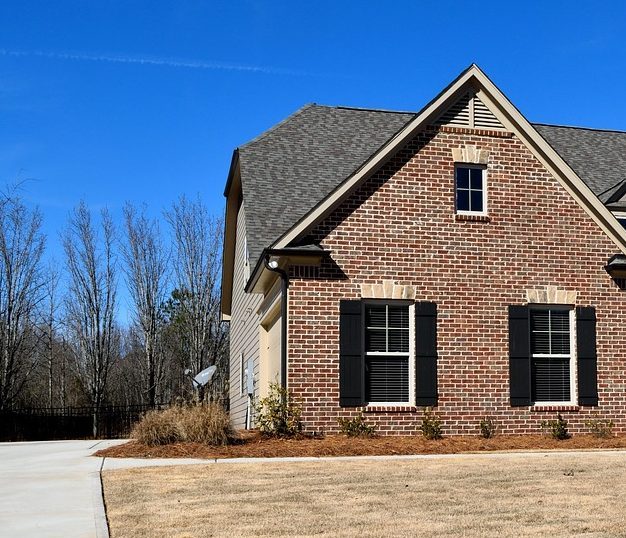
Take This Photo, For Example
Taking advantage of the depth of the front yard gives opportunities for repeating plant material without having to rely on symmetry. Research shows that people attach greater value to properties with attractively orchestrated plantings comprising wider beds and curved edges.
Enlarging the foundation plantings by bringing in a specimen and groups of plant material is usually more appealing. Try adding large curved beds in your drawings rather than narrow beds lined up against the wall. Curves soften rigid straight edges.
In the photograph, above, this landscape would gain depth by adding a new curved bed in the corner between the near side of the sidewalk and the driveway. I’d plant a small tree, several small flowering shrubs or evergreens, and flowers in this bed. Lastly, repetition, using the same ground cover on both sides of the sidewalk, not necessarily lined up, completes the picture. (Well, I might rethink those ornamental grasses…and…)
When installing a new sidewalk near the house, place it farther from the house, if possible, to accommodate more creative plantings.
Options For Cooling
Diagonally off the northeast corner of my last house in Rockville, Maryland, I planted a sourwood tree (Oxydendrum arboreum). This deciduous tree has spectacular red fall color. Although the tree is a slow grower, I selected it for its ornamental features: multi-stem trunk (usually sold with a single trunk), fine twigs, flowers after the peak spring season, pest-free foliage, and long-lasting fall color. With all those desirable features, I forgave its persistent seedpods.
During the growing season, the sourwood blocked morning sun, from the east-northeast, and helped cool the living room and the master bedroom upstairs. But, with winter’s sun rising in the east-southeast, the leafless tree did not affect light entering those rooms. In regions where the temperature climbs quickly early in the day, consider planting a tree to shade the morning sun.
On the west side of the property, monarch birches (Betula maximowicziana) provided afternoon shade. The fine texture of their leaves and branches cast a delicate shade, and those beautiful chalky white trunks contributed year-round interest. This species can be quite variable in trunk color, from white to gray to brown. I also planted the species Japanese snowbell (Styrax japonica), a small umbrella-shaped tree, off the west side of the brick patio.
When we first moved into the house, there was no relief from intense summer sun. Planting trees made good sense for this house with little insulation, original single-pane windows, and an inefficient HVAC system.
Over the next three decades, I renovated the entire house, insulated the attic and under new siding, planted a woodland, and greatly reduced our energy bills. Replacement double-pane windows, with that heat-reflective coating, were expensive, but worth it.
Headings:
Page 1: It’s Time To Plant Trees! (Room For Improvement), The Sun’s Path (For the Record), Drawing Up the Plans (Tools Of the Trade, Start the Sketch, Elevating Your Skills, Simple Might Work Better, Symmetry vs. Balance, Depth Perception, Take This Photo, For Example), and Options For Cooling
Page 2: Beautiful Trees In the Garden (Lessons From Well-Designed Gardens), First, Call 8-1-1, Establish the Hardscape, Dealing With Slope, Why Should We Plant Trees and Shrubs? (Planting Trees and Shrubs Can:, Finding Help), Choosing Plant Material, and Next: Part 2
